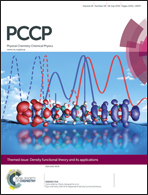A RRKM study and a DFT assessment on gas-phase fragmentation of formamide–M2+ (M = Ca, Sr)†
Abstract
A kinetic study of the unimolecular reactivity of formamide–M2+ (M = Ca, Sr) systems was carried out by means of RRKM statistical theory using high-level DFT. The results predict M2+, [M(NH2)]+ and [HCO]+ as the main products, together with an intermediate that could eventually evolve to produce [M(NH3)]2+ and CO, for high values of internal energy. In this framework, we also evaluated the influence of the external rotational energy on the reaction rate constants. In order to find a method to perform reliable electronic structure calculations for formamide–M2+ (M = Ca, Sr) at a relatively low computational cost, an assessment of different methods was performed. In the first assessment twenty-one functionals, belonging to different DFT categories, and an MP2 wave function method using a small basis set were evaluated. CCSD(T)/cc-pWCVTZ single point calculations were used as reference. A second assessment has been performed on geometries and energies. We found BLYP/6-31G(d) and G96LYP/6-31+G(d,p) as the best performing methods, for formamide–Ca2+ and formamide–Sr2+, respectively. Furthermore, a detailed assessment was done on RRKM reactivity and G96LYP/6-31G(d) provided results in agreement with higher level calculations. The combination of geometrical, energetics and kinetics (RRKM) criteria to evaluate DFT functionals is rather unusual and provides an original assessment procedure. Overall, we suggest using G96LYP as the best performing functional with a small basis set for both systems.


 Please wait while we load your content...
Please wait while we load your content...